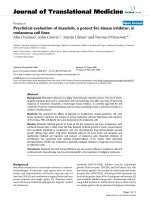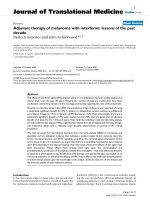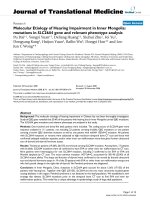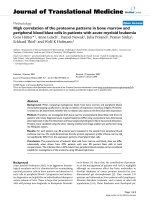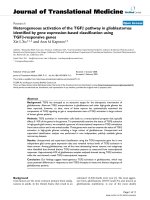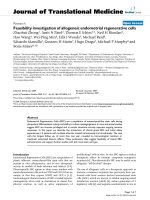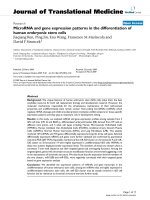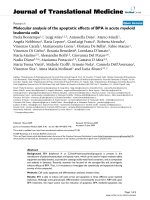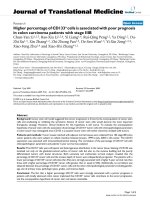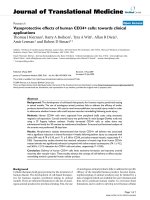báo cáo hóa học: " Do estimates of cost-utility based on the EQ-5D differ from those based on the mapping of utility scores?" pot
Bạn đang xem bản rút gọn của tài liệu. Xem và tải ngay bản đầy đủ của tài liệu tại đây (352.3 KB, 11 trang )
BioMed Central
Page 1 of 11
(page number not for citation purposes)
Health and Quality of Life Outcomes
Open Access
Research
Do estimates of cost-utility based on the EQ-5D differ from those
based on the mapping of utility scores?
Garry R Barton
1
, Tracey H Sach*
1,2,3
, Claire Jenkinson
3
, Anthony J Avery
3
,
Michael Doherty
4
and Kenneth R Muir
3
Address:
1
Health Economics Group, School of Medicine, Health Policy and Practice, University of East Anglia, Norwich, UK,
2
School of Chemical
Sciences and Pharmacy, University of East Anglia, Norwich, UK,
3
School of Community Health Sciences, University of Nottingham, Nottingham,
UK and
4
Academic Rheumatology, University of Nottingham, Nottingham, UK
Email: Garry R Barton - ; Tracey H Sach* - ; Claire Jenkinson - ;
Anthony J Avery - ; Michael Doherty - ;
Kenneth R Muir -
* Corresponding author
Abstract
Background: Mapping has been used to convert scores from condition-specific measures into utility scores, and
to produce estimates of cost-effectiveness. We sought to compare the QALY gains, and incremental cost per
QALY estimates, predicted on the basis of mapping to those based on actual EQ-5D scores.
Methods: In order to compare 4 different interventions 389 individuals were asked to complete both the EQ-
5D and the Western Ontartio and McMaster Universities Osteoarthritis Index (WOMAC) at baseline, 6, 12, and
24 months post-intervention. Using baseline data various mapping models were developed, where WOMAC
scores were used to predict the EQ-5D scores. The performance of these models was tested by predicting the
EQ-5D post-intervention scores. The preferred model (that with the lowest mean absolute error (MAE)) was
used to predict the EQ-5D scores, at all time points, for individuals who had complete WOMAC and EQ-5D data.
The mean QALY gain associated with each intervention was calculated, using both actual and predicted EQ-5D
scores. These QALY gains, along with previously estimated changes in cost, were also used to estimate the actual
and predicted incremental cost per QALY associated with each of the four interventions.
Results: The EQ-5D and the WOMAC were completed at baseline by 348 individuals, and at all time points by
259 individuals. The MAE in the preferred model was 0.129, and the mean QALY gains for each of the four
interventions was predicted to be 0.006, 0.058, 0.058, and 0.136 respectively, compared to the actual mean QALY
gains of 0.087, 0.081, 0.120, and 0.149. The most effective intervention was estimated to be associated with an
incremental cost per QALY of £6,068, according to our preferred model, compared to £13,154 when actual data
was used.
Conclusion: We found that actual QALY gains, and incremental cost per QALY estimates, differed from those
predicted on the basis of mapping. This suggests that though mapping may be of value in predicting the cost-
effectiveness of interventions which have not been evaluated using a utility measure, future studies should be
encouraged to include a method of actual utility measurement.
Trial registration: Current Controlled Trials ISRCTN93206785
Published: 14 July 2008
Health and Quality of Life Outcomes 2008, 6:51 doi:10.1186/1477-7525-6-51
Received: 4 February 2008
Accepted: 14 July 2008
This article is available from: />© 2008 Barton et al; licensee BioMed Central Ltd.
This is an Open Access article distributed under the terms of the Creative Commons Attribution License ( />),
which permits unrestricted use, distribution, and reproduction in any medium, provided the original work is properly cited.
Health and Quality of Life Outcomes 2008, 6:51 />Page 2 of 11
(page number not for citation purposes)
Background
Given that health care resources are scarce there is a need
to evaluate the cost-effectiveness of different health care
interventions. Within such studies economists generally
seek to measure the benefits in terms of utility, a scale
where 0 represents death and 1 is equivalent to full health,
in order for the benefits of many interventions to be com-
pared on a common scale [1-3]. However, as not all stud-
ies choose to measure outcomes in terms of utility, an
increasing amount of research has now been conducted
on mapping, where scores from a condition-specific (non
preference-based) measure are 'converted' into a utility
(preference-based) score using a pre-defined formulae [4].
Mapping thereby presents the possibility of estimating the
cost-utility (i.e. the incremental cost per quality adjusted
life year (QALY) [1]) of interventions that have previously
only been evaluated using a condition-specific measure.
Indeed a number of mapping models have now been
developed [5-19], the use of mapping has been consid-
ered by the UK National Institute of Health and Clinical
Excellence (NICE) [20], and mapping has been used to
estimate the utility scores, and in turn cost-effectiveness,
of a number of health care interventions [21-23]. The role
of this paper is to assess the criterion validity of such map-
ping procedures, as this represents an area where little
research has been undertaken. We achieve this by compar-
ing the actual estimated QALY gain associated with differ-
ent interventions to the QALY gains predicted on the basis
of mapping models, and similarly comparing the actual
incremental cost per QALY estimates associated with
those interventions to those derived from mapping mod-
els.
Methods
Participants
All individuals were taking part in the Lifestyle Interven-
tions for Knee Pain (LIKP) study, which was designed to
compare the effectiveness and cost-effectiveness of four
different interventions. The four interventions were
receipt of a leaflet, advice on knee strengthening exercises,
dietary advice, and both dietary and exercise advice (here-
after these interventions are referred to as 1, 2, 3 and 4 as
the main focus of this paper is methodological). Ethical
approval for this study was granted by the UK Nottingham
Research Ethics Committee. Recruitment into the LIKP
study began in May 2003 and ended in March 2005,
where all registered patients in five Nottingham general
practices who were aged ≥ 45 years, and deemed (by their
general practitioner) to be well enough to complete a
questionnaire, were sent an ascertainment questionnaire.
Additionally a local media campaign was conducted,
which included adverts in the local press and on the local
radio. Responding individuals were recruited into the
LIKP study if they reported that they had had knee pain on
most days of the last month, were aged ≥ 45 years, had a
body mass index (BMI) > 28.0 kg/m
2
, and gave consent to
be randomised to one of the four interventions.
Outcome measures
At both pre-intervention (baseline) and post-intervention
(at 6, 12 and 24 months) participants in the LIKP study
were asked to complete both the WOMAC (Western
Ontario and McMaster Universities Osteoarthritis Index)
and the EQ-5D.
The WOMAC contains 24 questions and measures the
amount of pain (5 questions), stiffness (2 questions), and
difficulty in physical functioning (17 questions), where
the response options are none (0), mild (1), moderate
(2), severe (3) or extreme (4) [24]. Scores can thereby
range between 0 and 20 on the pain sub-scale (pain), 0
and 8 on the stiffness sub-scale (stiffness), 0 and 68 on the
functioning sub-scale (functioning), and sum to between
0 to 96 (total WOMAC), where higher scores denote a
worse response [25,26]. Previous evidence of the ade-
quate performance of the WOMAC has been shown for
construct validity [27] and responsiveness [28,29].
The EQ-5D has five questions, where the respondent is
asked to report the level of problems they have (no prob-
lems, some/moderate problems, and severe/extreme
problems) with regard to mobility, self-care, usual activi-
ties, pain/discomfort, and anxiety/depression [30].
Responses to these five dimensions are converted into one
of 243 different EQ-5D health state descriptions, which
range between no problems on all five dimensions
(11111) and severe/extreme problems on all five dimen-
sions (33333). A utility score was assigned to each of these
243 health states using the York A1 tariff [31], which was
based on the preferences elicited from a survey of 3395
UK residents – EQ-5D scores range between -0.594 and 1
(full health).
Statistical analyses
Overview
We adopted a split-sample approach to the mapping of
condition-specific scores into utility scores. The baseline
scores from the aforementioned LIKP study were used to
develop various mapping models (to predict the EQ-5D
scores). The performance of those models was then
assessed on the post-intervention scores in order to iden-
tify our preferred model. Finally, for each of the four inter-
ventions, the actual QALY gains (over the 24 month trial
period), and the incremental cost per QALY estimates,
were compared to those that would have been predicted
on the basis of our preferred model.
Model specification
In line with previous mapping models [9,11-14,16-
19,22,23], we used linear regression analysis to predict the
Health and Quality of Life Outcomes 2008, 6:51 />Page 3 of 11
(page number not for citation purposes)
relationship between scores on a condition-specific meas-
ure and scores on a utility measure. Using baseline
WOMAC and EQ-5D data from the LIKP study, five mod-
els were developed, starting with the most parsimonious.
In each of the models different baseline WOMAC scores
took the form of independent variables and the baseline
EQ-5D score acted as the dependent variable. The predic-
tor variables in each of the five models were as follows.
Model A: total WOMAC;
Model B: pain, stiffness, functioning;
Model C: total WOMAC, total WOMAC
2
Model D: pain, stiffness, functioning, pain*stiffness,
pain*functioning, stiffness*functioning, pain
2
, stiffness
2
,
functioning
2
;
Model E: best of above models plus patient characteristics
of age and sex.
Model performance
We sought to identify our 'preferred' model, out of the five
aforementioned models, by comparing actual EQ-5D
scores to EQ-5D scores predicted on the basis of each of
the five mapping models. This comparison was performed
at 6, 12, and 24 months post-intervention for individuals
who had complete study data (i.e. completed both the
EQ-5D and each of the WOMAC sub-scales at all of the
four time points within our study). Baseline data was not
used within these comparisons as, in line with previous
studies [8,19], we sought to assess the performance of the
models on a different sample of data to that used to
develop the models. We inferred the 'preferred' model to
be the one with the lowest Mean Absolute Error (MAE),
where the MAE was calculated by taking the average value
of each absolute prediction error (the prediction error
equals the difference between the actual EQ-5D score, for
a particular individual, and, for the same individual, the
EQ-5D score predicted on the basis of the mapping
model). For each model we also report the adjusted
r
2
squared and the root mean square error (RMSE) (the
RMSE is the positive square root of the average squared
prediction error). Finally, in order to assess how well the
mapping formulae performs across the range of EQ-5D
scores, we also plot the actual follow-up EQ-5D scores
against the prediction errors (predicted score minus actual
score) from our inferred preferred model.
In line with the mapping models which are developed
here, a previous study has also attempted to predict utility
scores using scores on the WOMAC [19]. The study dif-
fered from ours in that it measured utility using the Health
Utilities Index [32], rather than the EQ-5D, and whilst
acknowledging that there is an argument that utilities
derived from different instruments should not be com-
pared [33], we also sought to compare the utility scores
predicted by the mapping models of Grootendorst et al.
[19] to our actual EQ-5D scores. Grootendorst et al. [19]
developed four models, but we were only able to predict
utility scores using the coefficient values from two of their
models (here referred to as G1 and G2) as the other two
models used independent variables (e.g. duration of oste-
oarthritis) which were not available for the individuals
within our study. Models G1 and G2 had the same inde-
pendent variables as our Model D, and G2 also included
the variables of age and sex. The performance of these two
models was again assessed by calculating the MAE, RMSE
and the adjusted r
2
squared. Additionally, we also identi-
fied our 'preferred' Grootendorst et al. model to be that
which had the lowest MAE.
Comparing actual trial results to those predicted using
mapping models
QALY gain
The LIKP study sought to estimate the effectiveness of four
different interventions. We thereby used the following
methods to compare the mean QALY gain (measured
from baseline over the 24 month trial period) for each of
the four interventions, as estimated by actual data, to that
predicted on the basis of our preferred mapping model
and our preferred Grootendorst et al. model. With regard
to actual data, for those participants who had complete
study data, the baseline and post-intervention (6, 12 and
24 month) EQ-5D scores were used to estimate the QALY
gain using the area under the curve (AUC) method, with
adjustment for baseline scores [34]. The mean QALY gains
were then calculated by estimating the average QALY gain
for the four groups of participants who received each of
the four interventions.
With regard to our preferred model, and our preferred
Grootendorst et al. model, EQ-5D scores were predicted at
baseline, 6, 12, and 24 months post-intervention for indi-
viduals who had complete study data (EQ-5D scores were
predicted at all time points as this method would be used
for studies which had not included a measure of utility).
Using the same methods as for the actual EQ-5D data (see
above), these predicted EQ-5D scores were then used to
estimate the QALY gain for each individual who had com-
plete study data, and the mean QALY gain for each inter-
vention, where these calculations were performed for
both our preferred model, and our preferred Grooten-
dorst et al. model. Finally, we compared the mean QALY
gain for each of the four interventions according to actual
EQ-5D data to that predicted on the basis of our preferred
mapping model, and our preferred Grootendorst et al.
model. The paired t-test was also used to assess whether
the actual mean QALY gains differed significantly (p <
Health and Quality of Life Outcomes 2008, 6:51 />Page 4 of 11
(page number not for citation purposes)
0.05) from those predicted on the basis of our preferred
model and our preferred Grootendorst et al. model.
Finally, it should be noted that discounting was not
undertaken in any of the above analysis as we sought to
identify the differences between the QALY gains based on
actual EQ-5D scores and those based on predicted EQ-5D
scores, and we sought to identify the difference that arose
due to the use of the mapping procedure.
Incremental cost per QALY
As described elsewhere (Barton GR, Sach TH, Avery AJ,
Doherty M, Jenkinson C, Muir KR. Lifestyle Interventions
for Knee Pain: Cost-effectiveness analysis. Paper submit-
ted for publication), levels of resource use were combined
with unit cost data to estimate the change in cost over the
two year study period for all participants in the LIKP study
(costs were calculated at 2005/6 levels, but in order to
ensure the same discount rate was applied to both costs
and benefits future costs were not discounted). The
change in costs, rather than total costs, was estimated due
to the presence of baseline differences in the analgesic
costs across each of the four interventions, and was calcu-
lated using the same aforementioned AUC technique as
was undertaken for QALYs. The mean change in cost was
thereby calculated for each of the four interventions.
These values along with the previously calculated QALY
gains based on i) actual EQ-5D scores, ii) the EQ-5D
scores predicted from our preferred model, and iii) the
EQ-5D scores predicted by our preferred Grootendorst et
al. model were then used to estimate the incremental cost
per QALY gain associated with each of the four interven-
tions (this is commonly referred to as the incremental
cost-effectiveness ratio (ICER) [1], and hereafter we refer
to it as the incremental cost per QALY). Incremental cost
per QALY estimates were made by ordering the four inter-
ventions from least costly to most costly, excluding those
interventions which were dominated (had a higher mean
change in cost and lower mean QALY gain than another
intervention) or were subject to extended dominance
(combinations of other interventions could provide a
higher benefit at lower/equivalent cost), and then calcu-
lating the ICER (incremental cost/incremental effect) for
remaining interventions. Separate incremental cost per
QALY estimates were made using each of the aforemen-
tioned three different methods of calculating a QALY gain.
Finally, it should be noted that all analyses were per-
formed in either SPSS [35] or Microsoft Excel.
Results
Participants
Across the five general practices 12,500 individuals were
sent an ascertainment questionnaire, and 8,044 (64.4%)
were returned. Subsequently, 318 individuals met the
entry criteria for the LIKP study, and gave consent to be
randomised to one of the four interventions. An addi-
tional 71 individuals were recruited via the media cam-
paign. The mean age of these 389 individuals was 62.0
years, 66.0% were female, and 23.4% were classified as
overweight (BMI 25 to < 30 kg/m
2
), 50.4% as class I obese
(30 to < 35 kg/m
2
), 16.9% as class II obese (35 to < 40 kg/
m
2
), and 9.9% as class III obese (≥ 40 kg/m
2
). At baseline
348 individuals fully completed both the EQ-5D and the
WOMAC, and data for these individuals were used to
develop the five mapping models. The mean score (95%
confidence interval) for these 348 individuals was 0.557
(0.528 to 0.587) on the EQ-5D, 7.76 (7.39 to 8.13) on the
pain sub-scale, 3.91 (3.74 to 4.07) on the stiffness scale,
27.89 (26.54 to 29.23) on the physical functioning scale,
and 39.55 (37.77 to 41.34) on the total WOMAC scale.
Statistical analyses
Model Specification and performance
The parameter estimates for each of the five models that
we developed to predict the baseline EQ-5D scores are
summarised in Table 1, where it should be remembered
that a higher WOMAC score denotes a worse response.
When these models were used to predict the EQ-5D scores
for the 259 individuals who had complete study data, it
can be seen that Model C had the lowest MAE (0.140) out
of the first four models when the actual scores at 6, 12 and
24 months were compared to those predicted on the basis
of these models. As such, Model E used the same inde-
pendent variables as model C, with the additional varia-
bles of age and sex. Model E had an MAE of 0.129, and
was thus deemed to be our preferred model (see Appendix
1 for full details of both Models C and E). By way of an
example of how these models are used to estimate EQ-5D
scores, our preferred model would predict that a male
with the aforementioned mean baseline characteristics
(age = 62 years; total WOMAC = 39.55) would have an
EQ-5D score of 0.577 (-0.3474012785 +
(-0.0005977709*39.55) + (-0.0001081560*39.55
2
) +
(0.0326027536*62) + (-0.0002352456*62
2
) +
(0.0475889687*0)), the actual mean baseline EQ-5D
score was 0.566 (95% confidence interval 0.532 to
0.600). Figure 1 shows how the prediction errors (pre-
dicted score minus absolute score) of our preferred model
(E) vary according to the actual EQ-5D scores (6, 12 and
24 month post-intervention data are plotted).
The parameter estimates for models G1 and G2 are pub-
lished in the appendix of the paper by Grootendorst et al.
[19]. In terms of performance, model G1 had a lower MAE
(0.142) than model G2 (0.144) and though both these
MAE were higher than that for Model E they were lower
than that for Model D, which used the same WOMAC pre-
dictor variables.
Health and Quality of Life Outcomes 2008, 6:51 />Page 5 of 11
(page number not for citation purposes)
Comparing actual trial results to those predicted using
mapping models
QALY gain
The WOMAC and EQ-5D were fully completed at base-
line, 6, 12 and 24 months post-intervention by 259 indi-
viduals (66.6% of trial participants). Based on the actual
EQ-5D scores for these individuals the mean QALY gain
(over the 2 year trial period, with adjustment for baseline
scores), for each of the four interventions, was estimated
to be 0.089, 0.081, 0.120 and 0.149, respectively. In Table
2 these values are compared to the mean QALY gains pre-
dicted by our preferred model (E), and our preferred
Grootendorst et al. model (G1). It can be seen that, for
each of the four interventions, the mean QALY gains
derived from both these preferred models were consist-
ently lower than the actual estimated mean QALY gains,
though the results were not significantly different.
Incremental cost per QALY
Based on the responses for the 259 individuals who had
complete study data the mean change in costs (standard
deviation) for each of the four interventions (1–4) was
estimated to be £7.75 (£122.66), £321.12 (£131.12),
£832.85 (£171.39) and £792.24 (£248.19), respectively.
These four mean change in costs were subsequently com-
bined with the estimated mean QALY gains, based on
both actual EQ-5D data and our preferred mapping mod-
els (as shown in Table 2), to give the incremental cost per
QALY estimates which are reported in Table 3. Based on
the actual EQ-5D scores intervention 4 had both a higher
mean effect, and lower mean increase in cost, than inter-
vention 3 – intervention 4 thereby dominated interven-
tion 3, and for similar reasons intervention 1 dominated
intervention 2. The incremental cost per QALY (ICER) for
intervention 4 was thereby calculated by comparing it to
Comparison of the actual EQ-5D scores and the prediction errors of Model EFigure 1
Comparison of the actual EQ-5D scores and the prediction errors of Model E.
Health and Quality of Life Outcomes 2008, 6:51 />Page 6 of 11
(page number not for citation purposes)
intervention 1, and was estimated to be £13,154
((792.24-7.72)/(0.149-0.089)).
These results, differed from those that were obtained
when the EQ-5D scores were predicted on the basis of our
preferred model, where though intervention 3 was still
dominated by intervention 4 intervention 2 was no longer
dominated by intervention 1. Instead intervention 2 had
an ICER of £6,036 (when compared to intervention 1),
and the ICER for intervention 4 was estimated to be
£6,068 (when compared to intervention 2) (see Table 3).
Similarly, though intervention 3 was still estimated to be
dominated by intervention 4 when model G1 was used to
predict the EQ-5D scores the incremental cost per QALY
results were again different from those based on the actual
EQ-5D scores: intervention 2 was now estimated to be
subject to extended dominance as combinations of inter-
ventions 1 and 4 could provide a higher benefit at lower
cost (see [36] for further information on how to deter-
mine when an intervention is subject to extended domi-
nance), and the ICER for intervention 4 was estimated to
be £6,345 (when compared to intervention 1) (see Table
3).
Discussion
Within this paper we have shown how mapping models
can be used to predict the QALY gain associated with dif-
ferent interventions, and in turn calculate the ICER associ-
ated with different interventions. When these predicted
results are compared to actual results we found that our
preferred model consistently underestimated the mean
QALY gain associated with the four compared interven-
tions. The ICER of each of the four interventions, based on
actual data, also differed from that based on our preferred
mapping model (see Table 3) – the most effective inter-
vention (intervention 4) was estimated to be more cost-
effective according to our preferred mapping model
(ICER = £6,068), compared to when actual data was used
(ICER = £13,154).
Within this paper we also calculated the incremental cost
per QALY estimates for the four interventions in the LIKP
Table 1: Parameter estimates for the five models which were used to predict the baseline EQ-5D scores.
Model
AB C D E
Intercept 0.900‡ 0.886‡ 0.747‡ 0.691‡ -0.347
total WOMAC -0.009‡ 0.001 -0.001
pain -0.012 -0.009
stiffness 0.006 0.092†
functioning -0.009‡ -0.005
pain* stiffness -0.005
pain*functioning -0.001
stiffness*functioning 0.001
pain
2
0.002
stiffness
2
-0.011
functioning
2
0.000
total WOMAC
2
-0.000‡ -0.000†
age 0.033*
age
2
0.000
sex (if Female) 0.048
Range of predicted scores 0.086 to 0.900 0.086 to 0.900 -0.235 to 0.748 -0.111 to 0.852 -0.184 to 0.828
MAE 0.148 0.147 0.140 0.146 0.129
Adjusted r
2
0.275 0.274 0.296 0.299 0.313
RMSE 0.189 0.187 0.185 0.190 0.180
* = p < 0.05, † = p < 0.01, ‡ = p < 0.001, MAE = Mean Absolute Error, RMSE = Root Mean Squared Error. See Appendix 1 for full details of Model
C and Model E.
Table 2: Mean estimated QALY gains based on both actual data and mapping models.
Intervention 1 2 3 4
Actual results 0.089 (0.330) 0.081 (0.428) 0.120 (0.450) 0.149 (0.352)
Model E 0.006 (0.162) 0.058 (0.186) 0.058 (0.158) 0.136 (0.209)
Model G1 -0.009* (0.146) 0.027 (0.166) 0.062 (0.149) 0.114 (0.186)
Standard deviations are presented in brackets, * = p < 0.05 according to the paired t-test
Health and Quality of Life Outcomes 2008, 6:51 />Page 7 of 11
(page number not for citation purposes)
study using a previously published mapping model based
on the HUI3. This approach is justified by the following
example. In a previous study by Thomas et al. [37] it was
found that a home exercise programme for people with
knee pain was more effective than no intervention, and
more costly, but as effectiveness was only measured on the
WOMAC one could not compare the cost-effectiveness of
this new intervention to other health-care interventions,
or the cost-effectiveness threshold. One possible way of
estimating the cost-effectiveness of the home exercise pro-
gramme would be to convert the WOMAC scores into util-
ity scores using the mapping scores published by
Grootendorst et al. [19]. Interestingly, within this paper,
our preferred Grootendorst et al. model had a lower MAE
than was the case in the original data set within which it
was developed (0.142 compared to 0.1645). Furthermore,
the predicted incremental cost per QALY estimates based
on our preferred Grootendorst et al. model, which was
developed using the HUI3, were also numerically closer to
the actual incremental cost per QALY estimates, than was
the case for the predicted cost per QALY estimates based
on our preferred model, which was developed using the
EQ-5D (see Table 3).
Explanations
One possible explanation for the above QALY differences
is as follows. Figure 1 shows that that the prediction errors
of our preferred model tend to be increasingly positive for
lower EQ-5D scores and increasingly negative for higher
EQ-5D scores. This suggests that the regression would
tend to over predict the EQ-5D score for those at low lev-
els of utility, and under predict the EQ-5D score for those
at high levels of utility. As the EQ-5D scores tend to
increase post-intervention (baseline mean EQ-5D score =
0.566 and 24 month mean = 0.639, for N = 259), the con-
sequence of this is that the final EQ-5D scores tend to be
underestimated and thus the QALY gain associated with
each of the four interventions also tends to be underesti-
mated. This is further demonstrated by plotting the pre-
dicted errors against the actual EQ-5D scores at baseline
(Figure 2a) and at 24 months post-intervention (Figure
2b), where the fact that the prediction errors are more
likely to be negative at 24 months indicates that the actual
scores were more likely to exceed the predicted scores at
this time period, than was the case at baseline. However,
it should be noted that, even though the effectiveness of
each intervention was predicted to be lower by the map-
ping models, the most effective intervention (4) was esti-
mated to have a more favourable incremental cost per
QALY estimate according to the mapping models as the
predicted mean QALY gain for this intervention was closer
to the actual estimate, than was the case for the three other
interventions (see Table 2).
A further explanation as to why the QALY gains predicted
by the mapping formulae tend to underestimate the
actual QALY gain may be that the benefits of the interven-
tions are not fully captured by the WOMAC, which con-
centrates on pain, stiffness and physical functioning.
Thus, if there are other benefits, which are not detected by
the WOMAC, then this may also explain why the mapping
formulae tends to under predict the actual QALY gains
associated with each of the four interventions. This hypo-
thesis concurs with that of others who have pointed out
that mapping models can only encompass the gains that
are detected by the condition-specific measure [10].
Comparisons with other studies
We are aware of two papers which have compared both
the QALY gain and incremental cost per QALY predicted
on the basis of different mapping formulae [38,39]. Pick-
ard et al. [38] used ten different mapping models, four of
which were based on the SF-12 [40], and six on SF-36
[41]. They then used both the before and after scores from
both a group of asthma patients, and a group of stroke
patients, to estimate the 1 year QALY gain, and the associ-
ated incremental cost per QALY (for both groups of
patients it was assumed that the incremental cost of the
intervention was $2000 greater than standard treatment).
They found that the QALY gain (incremental cost per
QALY) estimates for the asthma patients ranged between
0.032 and 0.065 ($30,769 to $63,492), and that the
QALY gain for the stroke patients ranged between 0.028 to
0.072 ($27,972 to $72,727) [38]. Thus, the results of Pick-
ard et al. [38], are in line with ours, in that the estimated
ICER varies according to which algorithm is used. This
was also the case in the study by Marra et al. [39], who
used mapping to estimate the ICER associated with two
different drug strategies for patients with rheumatoid
arthritis. Using a previous database, mapping models
were created by estimating the relationship between the
Health Assessment Questionnaire [42] and the utility
measures of the EQ-5D [30], SF-6D [43], HUI2 and HUI3
[32]. The four created mapping models were then used to
estimate the QALY gain associated with the two different
drug strategies in a different data set, where the results for
the two treatments were 3.33 and 4.67 for the EQ-5D
mapping model, 3.79 to 4.69 for the SF-6D, 4.16 to 5.33
for the HUI2, and 1.73 to 3.68 for the HUI3. These values
were used to estimate the incremental effect, and when
Table 3: Estimated incremental cost per QALY based on both
actual data and mapping models.
Intervention 1 2 3 4
Actual results N/A D by 1 D by 4 £13,154
Model E N/A £6,036 D by 4 £6,086
Model G1 N/A Subject to ED D by 4 £6,345
N/A = Not applicable (this intervention is the least costly and least
effective), ED = Extended dominance, D = Dominated
Health and Quality of Life Outcomes 2008, 6:51 />Page 8 of 11
(page number not for citation purposes)
Comparison of the actual EQ-5D scores and the prediction errors of Model EFigure 2
Comparison of the actual EQ-5D scores and the prediction errors of Model E.
Health and Quality of Life Outcomes 2008, 6:51 />Page 9 of 11
(page number not for citation purposes)
accompanied by estimates of the incremental cost, the
ICER was estimated to range between $32,018 (HUI3)
and $69,826 (SF-6D).
We also sought to compare our results to those of others
who have used similar techniques to estimate the relation-
ship between scores on a condition-specific measure and
scores on a utility measure [9,11-14,16-19,22,23]. Not all
of these studies reported the mean absolute error (MAE)
but reported values did include < 0.13 [17], 0.14 to 0.16
[17,18], 0.1628 [19] and 0.19 [12], all of which are gener-
ally comparable to the MAE of our preferred model
(0.129). Within these other studies, and the mapping
models that we developed (see Table 1), there was also a
tendency for the agreement between the observed and
predicted utility scores to improve as further socio-demo-
graphic variables were used to predict the variation in the
utility scores (in an attempt to ensure that others can use
the mapping formulae that we developed we only
included the socio-demographic variables of age and sex
in our preferred model as we considered that other varia-
bles would not be routinely recorded in other studies).
Implications
One possible implication of the results presented here is
that, as the scores predicted on the basis of mapping differ
from actual scores, utility estimates that are based on
mapping models should not be seen as a substitute for
actual utility measurement. As a consequence, prospective
clinical trials should seek to measure outcomes with a util-
ity measure, rather than using a condition specific meas-
ure and a mapping model to estimate the utility gain
associated with an intervention. There may however still
be a role for mapping in terms of estimating the utility
score in previous studies which have only included a non-
preference based outcome measure. For example, in the
aforementioned study by Thomas et al. [37], it was found
that the new intervention was more costly and more effec-
tive (on the WOMAC), but without translating the scores
on the WOMAC into utility scores we have no way of try-
ing to estimate whether the additional benefits are worth-
while i.e. we can not determine whether it is cost-effective
to provide the new intervention, or whether it would be
more cost-effective to spend scarce health care resources
elsewhere. Indeed a recent report by the UK NICE relied
heavily on the use of mapping to estimate the cost-effec-
tiveness of a number of interventions concerned with the
care and management of osteoarthritis in adults [44]. Fur-
ther justification for the use of mapping is also provided
by the results of this study, in that had we only measured
outcomes with the WOMAC, and used a previously pub-
lished mapping model [19] to estimate the QALY gains,
and incremental cost per QALY, associated with each of
the four interventions (as we did in Table 3) then we
would have come to the same conclusion i.e. that inter-
vention 4 was the most cost-effective intervention as it has
an incremental cost per QALY which is less than the
£30,000 per QALY cut-off which has been argued to rep-
resent the approximate cost-effectiveness threshold which
has been used by NICE [45-47] (NICE states that it oper-
ates to a threshold range of £20,000 to £30,000 per QALY
[48]).
Strengths and weaknesses
We consider the main potential limitation of our study to
be that the results may not be generalizable. This arises
because we only used the WOMAC to predict the EQ-5D
score, and other studies which use a different condition-
specific measure, or utility measure, may find the actual
study results are more similar to those predicted on the
basis of the mapping models. Our results are however
important as evidence as to the validity of mapping, in
terms of how closely incremental cost per QALY estimates
based on actual results align to those based on mapping,
can only be provided by a series of converging results [49].
Moreover, in an attempt to increase the generalizability of
our results we sought to develop mapping formulae using
the technique of linear regression as this is the technique
that is most commonly used within the literature [9,11-
14,16-19,22,23]. We do however appreciate that, as the
utility scale is bounded, the technique of linear regression
can result in biased and inconsistent estimates [50,51]. As
such it may be that other techniques such as Tobit regres-
sion, the censored least absolute deviations (CLAD) esti-
mator [9] and restricted maximum likelihood (REML) [8]
could result in a smaller MAE and better prediction.
A further potential weakness of this paper is that we have
used various approaches (e.g. a complete case analysis
and discounting of future costs and benefits at 0%) which
might not be undertaken in standard cost-effectiveness
analysis. Techniques such as discounting and imputation
[1] were not used as the main focus of this paper was
methodological, and we sought to identify the true differ-
ence between actual and predicted scores that arose due to
mapping. Additionally, we did not explore the potential
for selection bias that might arise due to the recruitment
of participants from two different sources (recruitment via
local general practices compared to the local media cam-
paign).
The main strength of our paper is that this is one of the
first studies to compare the actual QALY gain associated
with particular interventions to the QALY gain that would
have been predicted, for the same interventions, on the
basis of mapping. Moreover, this comparison has been
undertaken using both mapping models developed from
both the LIKP study data, and from a previous paper [19].
We are aware of two papers [38,39] who make similar
incremental cost per QALY comparisons. We build upon
Health and Quality of Life Outcomes 2008, 6:51 />Page 10 of 11
(page number not for citation purposes)
the first of these papers [38] by making incremental cost
per QALY comparisons using mapping models that are
based on a condition-specific measure, rather than the
more generic measures of the SF-12 [40] and SF-36 [41],
by using actual cost estimates for actual interventions, and
by making comparisons with a different measure of utility
(the EQ-5D). We similarly advance upon the second
paper [39] as they undertook incremental cost per QALY
calculations using a number of mapping formulae, but
did not include an actual measure of utility within their
comparisons.
Conclusion
We have shown how mapping can be used to estimate
both the QALY gain, and incremental cost per QALY, asso-
ciated with different interventions, and compared these
predictions to actual results. In our study the mapping
models developed from the WOMAC tended to underes-
timate the QALY gain associated with each of four inter-
ventions, compared to that which was derived from actual
EQ-5D scores. Similarly, the incremental cost per QALY
estimates based on the mapping models also differed
from those based on actual data. This suggests that future
trials should include a measure of utility, however map-
ping may still be useful in estimating the cost-effective-
ness of interventions which have previously only been
evaluated with a condition-specific measure.
Appendix 1
Model C: Predicted EQ-5D score = 0.746652555353163 +
(0.000810215321934668* total WOMAC) + (-
0.000119664323424435* total WOMAC
2
)
Model E: Predicted EQ-5D score = -0.3474012785 + (-
0.0005977709* total WOMAC) + (-0.0001081560* total
WOMAC
2
) + (0.0326027536*age) + (-
0.0002352456*age
2
) + (0.0475889687*sex))
sex is equal to 1 if Female and 0 if male.
Competing interests
The authors declare that they have no competing interests.
Authors' contributions
GB and TS conceived the idea for the paper, undertook the
analysis and drafted the paper. CJ, AA, MD, and KM
assisted in the acquisition of data, interpretation of the
analysis, and commented on drafts of the manuscript. All
authors read and approved the final manuscript.
Acknowledgements
We thank all participants who completed the Lifestyle Interventions for
Knee Pain (LIKP) study questionnaire. The LIKP study was funded by the
UK Arthritis Research Campaign (ARC) (grant number 13550). The funding
body have not commented on the work presented in this manuscript. A
previous version of this paper was presented at the UK Health Economics
Study Group, University of East Anglia, January 2008. Finally, we also
acknowledge the useful comments made by two anonymous referees.
References
1. Drummond MF, Sculpher MJ, Torrance GW, O'Brien BJ, Stoddart GL:
Methods for the Economic Evaluation of Health Care Programmes 3rd edi-
tion. New York: Oxford University Press; 2005.
2. Barton GR, Bankart J, Davis AC: A comparison of the quality of
life of hearing-impaired people as estimated by three differ-
ent utility measures. Int J Audiol 2005, 44:157-163.
3. Sach TH, Barton GR, Doherty M, Muir K, Jenkinson C, Avery AJ: The
relationship between BMI and health related quality of life:
comparing the EQ-5D, EuroQol VAS, and SF-6D. Int J Obes
Relat Metab Disord 2007, 31:189-196.
4. Brazier JE, Ratcliffe J, Salomon JA, Tsuchiya A: Measuring and Valuing
Health Benefits for Economic Evaluation New York: Oxford University
Press Inc.; 2007.
5. Sengupta N, Nichol MB, Wu J, Globe D: Mapping the SF-12 to the
HUI3 and VAS in a managed care population. Med Care 2004,
42:927-937.
6. Brennan DS, Spencer AJ: Mapping oral health related quality of
life to generic health state values. BMC Health Serv Res 2006,
6:96.
7. Gray AM, Rivero-Arias O, Clarke PM: Estimating the association
between SF-12 responses and EQ-5D utility values by
response mapping. Med Decis Making 2006, 26:18-29.
8. Buxton MJ, Lacey LA, Feagan BG, Niecko T, Miller DW, Townsend
RJ: Mapping from disease-specific measures to utility: an
analysis of the relationships between the Inflammatory
Bowel Disease Questionnaire and Crohn's Disease Activity
Index in Crohn's disease and measures of utility. Value Health
2007, 10:214-220.
9. Sullivan PW, Ghushchyan V: Mapping the EQ-5D index from the
SF-12: US general population preferences in a nationally rep-
resentative sample. Med Decis Making 2006, 26:401-409.
10. Brazier JE, Kolotkin RL, Crosby RD, Williams GR: Estimating a
Preference-Based Single Index for the Impact of Weight on
Quality of Life-Lite (IWQOL-Lite) Instrument from the SF-
6D. Value Health 2004, 7:490-498.
11. Bansback N, Marra C, Tsuchiya A, Anis A, Guh D, Hammond T, Bra-
zier J: Using the health assessment questionnaire to estimate
preference-based single indices in patients with rheumatoid
arthritis. Arthritis Rheum
2007:963-971.
12. Dobrez D, Cella D, Pickard AS, Lai JS, Nickolov A: Estimation of
patient preference-based utility weights from the functional
assessment of cancer therapy – general. Value Health 2007,
10:266-272.
13. Lawrence WF, Fleishman JA: Predicting EuroQoL EQ-5D prefer-
ence scores from the SF-12 Health Survey in a nationally
representative sample. Med Decis Making 2004, 24:160-169.
14. Longworth L, Buxton MJ, Sculpher M, Smith DH: Estimating utility
data from clinical indicators for patients with stable angina.
Eur J Health Econ 2005, 6:347-353.
15. Yang M, Dubois D, Kosinski M, Sun X, Gajria K: Mapping MOS
Sleep Scale scores to SF6D utility index. Curr Med Res Opin
2007, 23:2269-2282.
16. Nichol MB, Sengupta N, Globe DR: Evaluating quality-adjusted
life years: estimation of the health utility index (HUI2) from
the SF-36. Med Decis Making 2001, 21:105-112.
17. Franks P, Lubetkin EI, Gold MR, Tancredi DJ, Jia H: Mapping the SF-
12 to the EuroQol EQ-5D Index in a national US sample. Med
Decis Making 2004, 24:247-254.
18. Franks P, Lubetkin EI, Gold MR, Tancredi DJ: Mapping the SF-12 to
preference-based instruments: convergent validity in a low-
income, minority population. Med Care 2003, 41:1277-1283.
19. Grootendorst P, Marshall D, D P, Bellamy N, Feeny D, Torrance GW:
A model to estimate health utilities index mark 3 utility
scores from WOMAC index scores in patients with osteoar-
thritis of the knee. J Rheumatol 2007, 34:534-542.
20. National Institute of Health and Clinical Excellence: Guide to the Meth-
ods of Technology Appraisal 2007 [
]. (Draft for
consultation).
21. Barton P, Jobanputra P, Wilson J, Bryan S, Burls A: The use of mod-
elling to evaluate new drugs for patients with a chronic con-
Publish with BioMed Central and every
scientist can read your work free of charge
"BioMed Central will be the most significant development for
disseminating the results of biomedical research in our lifetime."
Sir Paul Nurse, Cancer Research UK
Your research papers will be:
available free of charge to the entire biomedical community
peer reviewed and published immediately upon acceptance
cited in PubMed and archived on PubMed Central
yours — you keep the copyright
Submit your manuscript here:
/>BioMedcentral
Health and Quality of Life Outcomes 2008, 6:51 />Page 11 of 11
(page number not for citation purposes)
dition: the case of antibodies against tumour necrosis factor
in rheumatoid arthritis. Health Tech Assess 2004, 8(11):1-104.
22. Brennan A, Bansback N, Reynolds A, Conway P: Modelling the
cost-effectiveness of etanercept in adults with rheumatoid
arthritis in the UK. Rheumatology 2004 2004, 43:62-72.
23. Summerfield Q, Barton GR, Toner J, McAnallen C, et al.: Self-
reported benefits from successive bilateral cochlear implan-
tation in post-lingually deafened adults: randomised control-
led trial. International Journal of Audiology 2006, 45:S99-S107.
24. Bellamy N, Buchanan WW, Goldsmith CH, Campbell J, Stitt LW: Val-
idation study of WOMAC: a health status instrument for
measuring clinically important patient relevant outcomes to
antirheumatic drug therapy in patients with osteoarthritis of
the hip or knee. J Rheumatol 1988, 15:1833-1840.
25. Bellamy N: WOMAC: a 20-year experiential review of a
patient-centered self-reported health status questionnaire. J
Rheumatol 2002, 29:2473-2476.
26. McCarthy CJ, Mills PM, Pullen R, Richardson G, Hawkins N, Roberts
CR, Silman AJ, Oldham JA: Supplementation of a home-based
exercise programme with a class-based programme for peo-
ple with osteoarthritis of the knees: a randomised controlled
trial and health economic analysis. Health Technol Assess 2004,
8(46):1-61.
27. Miller GD, Rejeski WJ, Williamson JD, Morgan T, Sevick MA, Loeser
RF, Ettinger WH, Messier SP, Investigators A: The Arthritis, Diet
and Activity Promotion Trial (ADAPT): design, rationale,
and baseline results. Control Clin Trials 2003, 24:462-480.
28. Davies GM, Watson DJ, Bellamy N: Comparison of the respon-
siveness and relative effect size of the western Ontario and
McMaster Universities Osteoarthritis Index and the short-
form Medical Outcomes Study Survey in a randomized, clin-
ical trial of osteoarthritis patients. Arthritis Rheum 1999,
12:172-179.
29. Theiler R, Bischoff-Ferrari HA, Good M, Bellamy N: Responsive-
ness of the electronic touch screen WOMAC 3.1 OA Index
in a short term clinical trial with rofecoxib. Osteoarthritis Carti-
lage 2004, 12:912-916.
30. Brooks R: EuroQol: the current state of play. Health Policy 1996,
37:53-72.
31. Dolan P: Modelling valuations for EuroQol health states. Med
Care 1997, 35:1095-1108.
32. Feeny D, Furlong W, Torrance GW, Goldsmith CH, Zhu Z, DePauw
S, Denton M, Boyle M: Multi-attribute and single attribute util-
ity functions for the Health Utilities Index Mark 3 system.
Med Care 2002, 40:113-128.
33. Lenert L, Kaplan RM: Validity and interpretation of preference-
based measures of health-related quality of life. Med Care
2000, 38(Suppl 9):138-150.
34. Manca A, Hawkins N, Sculpher MJ: Estimating mean QALYs in
trial-based cost-effectiveness analysis: the importance of
controlling for baseline utility. Health Econ 2005, 14:487-496.
35. Statistical Package for the Social Sciences (SPSS): SPSS for Windows,
release 13.0 [ />]. Chicago, Illinois: SPSS Inc
36. UK BEAM Trial Team: United Kingdom back pain exercise and
manipulation (UK BEAM) randomised trial: cost effective-
ness of physical treatments for back pain in primary care.
BMJ 2004, 329:1381.
37. Thomas KS, Miller P, Doherty M, Muir KR, Jones AC, O'Reilly SC:
Cost effectiveness of a two-year home exercise program for
the treatment of knee pain. Arthritis Rheum 2005, 53:388-94.
38. Pickard AS, Wang Z, Walton SM, Lee TA: Are decisions using
cost-utility analyses robust to choice of SF-36/SF-12 prefer-
ence-based algorithm? Health Qual Life Outcomes 2005, 3:11.
39. Marra CA, Marion SA, Guh DP, Najafzadeh M, Wolfe F, Esdaile JM,
Clarke AM, Gignac AH, Anis AH: Not all "quality-adjusted life
years" are equal. J Clin Epidemiol 2007:616-624.
40. Ware JE, Kosinski M, Keller SD: A 12-Item Short-Form Health
Survey: Construction of scales and preliminary tests of relia-
bility and validity. Med Care 1996, 34:220-233.
41. Ware JE, Sherbourne C: The MOS 36 item short-form health
survey: Conceptual framework and item selection. Med Care
1992, 30:473-483.
42. Fries J, Spitz P, Kraines R, Holman H: Measurement of patient
outcomes in rheumatoid arthritis. Arthritis Rheum 1980:137-145.
43. Brazier JE, Roberts J, Deverill M: The estimation of a preference-
based measure of health from the SF-36. J Health Econ 2002,
21:271-292.
44. National Institute of Clinical and Health Excellence (NICE): NICE
Guideline project – Osteoarthritis: the care and management of osteoarthri-
tis in adults 2007 [
].
45. Appleby J, Devlin N, Parkin D: NICE's cost effectiveness thresh-
old. BMJ 2007, 335:358-359.
46. Dakin HA, Devlin NJ, Odeyemi IA: Yes", "No" or "Yes, but"?
Multinomial modelling of NICE decision-making. Health Policy
2006, 77:352-367.
47. Raftery JP: Review of NICE's recommendations, 1999–2005.
BMJ 2006, 332:1266-1268.
48. National Institute of Health and Clinical Excellence: Guide to the Meth-
ods of Technology Appraisal London, UK: Abba Litho Sales Limited;
2004.
49. Streiner DL, Norman GR: Health Measurement Scales: a practical guide
to their development and use 3rd edition. New York: Oxford University
Press; 2003.
50. Austin PC, Escobar M, Kopec JA: The use of the Tobit model for
analysing measures of health status. Qual Life Res 2000:901-910.
51. Green WH: Econometric analysis 4th edition. NJ: Prentice-Hall; 2000.
